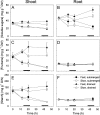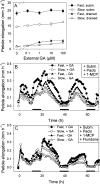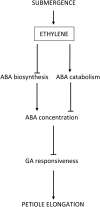Endogenous abscisic acid as a key switch for natural variation in flooding-induced shoot elongation
- PMID: 20699400
- PMCID: PMC2949041
- DOI: 10.1104/pp.110.162792
Endogenous abscisic acid as a key switch for natural variation in flooding-induced shoot elongation
Abstract
Elongation of leaves and stem is a key trait for survival of terrestrial plants during shallow but prolonged floods that completely submerge the shoot. However, natural floods at different locations vary strongly in duration and depth, and, therefore, populations from these locations are subjected to different selection pressure, leading to intraspecific variation. Here, we identified the signal transduction component that causes response variation in shoot elongation among two accessions of the wetland plant Rumex palustris. These accessions differed 2-fold in petiole elongation rates upon submergence, with fast elongation found in a population from a river floodplain and slow elongation in plants from a lake bank. Fast petiole elongation under water consumes carbohydrates and depends on the (inter)action of the plant hormones ethylene, abscisic acid, and gibberellic acid. We found that carbohydrate levels and dynamics in shoots did not differ between the fast and slow elongating plants, but that the level of ethylene-regulated abscisic acid in petioles, and hence gibberellic acid responsiveness of these petioles explained the difference in shoot elongation upon submergence. Since this is the exact signal transduction level that also explains the variation in flooding-induced shoot elongation among plant species (namely, R. palustris and Rumex acetosa), we suggest that natural selection results in similar modification of regulatory pathways within and between species.
Figures





Similar articles
-
Intraspecific variation in the magnitude and pattern of flooding-induced shoot elongation in Rumex palustris.Ann Bot. 2009 Nov;104(6):1057-67. doi: 10.1093/aob/mcp198. Epub 2009 Aug 16. Ann Bot. 2009. PMID: 19687030 Free PMC article.
-
Interactions between plant hormones regulate submergence-induced shoot elongation in the flooding-tolerant dicot Rumex palustris.Ann Bot. 2003 Jan;91 Spec No(2):205-11. doi: 10.1093/aob/mcf116. Ann Bot. 2003. PMID: 12509341 Free PMC article. Review.
-
The roles of ethylene, auxin, abscisic acid, and gibberellin in the hyponastic growth of submerged Rumex palustris petioles.Plant Physiol. 2004 Oct;136(2):2948-60; discussion 3001. doi: 10.1104/pp.104.049197. Epub 2004 Oct 1. Plant Physiol. 2004. PMID: 15466223 Free PMC article.
-
Long-term submergence-induced elongation in Rumex palustris requires abscisic acid-dependent biosynthesis of gibberellin1.Plant Physiol. 2006 Aug;141(4):1644-52. doi: 10.1104/pp.106.082636. Epub 2006 Jun 9. Plant Physiol. 2006. PMID: 16766669 Free PMC article.
-
Submergence research using Rumex palustris as a model; looking back and going forward.J Exp Bot. 2002 Mar;53(368):391-8. doi: 10.1093/jexbot/53.368.391. J Exp Bot. 2002. PMID: 11847236 Review.
Cited by
-
Growth and Physiological Responses to Water Depths in Carex schmidtii Meinsh.PLoS One. 2015 May 26;10(5):e0128176. doi: 10.1371/journal.pone.0128176. eCollection 2015. PLoS One. 2015. PMID: 26009895 Free PMC article.
-
Transcriptomes of Eight Arabidopsis thaliana Accessions Reveal Core Conserved, Genotype- and Organ-Specific Responses to Flooding Stress.Plant Physiol. 2016 Oct;172(2):668-689. doi: 10.1104/pp.16.00472. Epub 2016 May 15. Plant Physiol. 2016. PMID: 27208254 Free PMC article.
-
A comparison of screening methods to identify waterlogging tolerance in the field in Brassica napus L. during plant ontogeny.PLoS One. 2014 Mar 3;9(3):e89731. doi: 10.1371/journal.pone.0089731. eCollection 2014. PLoS One. 2014. PMID: 24594687 Free PMC article.
-
Integrated analysis of transcriptome and microRNAs associated with exogenous calcium-mediated enhancement of hypoxic tolerance in cucumber seedlings (Cucumis sativus L.).Front Plant Sci. 2023 Jan 4;13:994268. doi: 10.3389/fpls.2022.994268. eCollection 2022. Front Plant Sci. 2023. PMID: 36684729 Free PMC article.
-
The Contribution of Plant Dioxygenases to Hypoxia Signaling.Front Plant Sci. 2020 Jul 8;11:1008. doi: 10.3389/fpls.2020.01008. eCollection 2020. Front Plant Sci. 2020. PMID: 32733514 Free PMC article. Review.
References
-
- Bailey-Serres J, Voesenek LACJ. (2008) Flooding stress: acclimations and genetic diversity. Annu Rev Plant Biol 59: 313–339 - PubMed
-
- Banga M, Bögemann GM, Blom CWPM, Voesenek LACJ. (1997) Flooding resistance of Rumex species strongly depends on their response to ethylene: rapid shoot elongation or foliar senescence. Physiol Plant 99: 415–422
-
- Bartelheimer M, Gowing D, Silvertown J. (2010) Explaining hydrological niches: the decisive role of below-ground competition in two closely related Senecio species. J Ecol 98: 126–136
-
- Benschop JJ, Jackson MB, Guhl K, Vreeburg RAM, Croker SJ, Peeters AJM, Voesenek LACJ. (2005) Contrasting interactions between ethylene and abscisic acid in Rumex species differing in submergence tolerance. Plant J 44: 756–768 - PubMed
Publication types
MeSH terms
Substances
Associated data
- Actions
LinkOut - more resources
Full Text Sources

